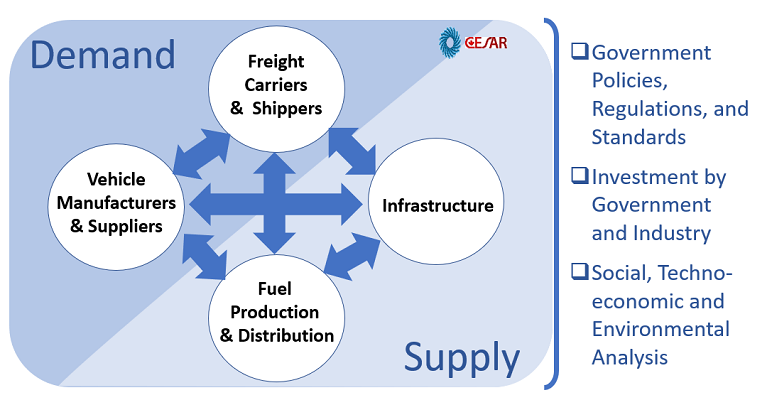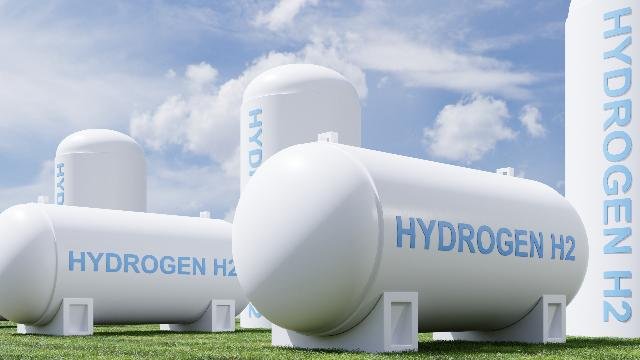Hydrogen in Alberta
Hydrogen is powering the shift to zero-emission commercial transport. Through the AZETEC Project, Alberta is using its energy expertise to lead in low-carbon hydrogen production. By investing in advanced technologies like fuel cells, steam reformers, and electrolyzers, we’re turning local resources into clean fuel — supporting economic growth, environmental goals, and a sustainable future for heavy-duty transportation.
Hydrogen
Hydrogen is the most abundant element in the universe, but it does not typically appear in isolation. It can be found in water, fossil fuels, or biomass. To extract hydrogen, processes such as electrolysis or steam methane reforming are used. By investing in a portfolio of non-combustion hydrogen production technologies, including steam reformers and electrolyzers, commercial vehicle developers transform various types of feedstocks into hydrogen with low-to-negative carbon intensity.
In commercial vehicles, hydrogen is used as a source of fuel, held in specially made tanks. Hydrogen from the tanks is then funneled into the fuel cell system, where it combines with air to generate electricity that powers vehicles with zero emissions.
Where does hydrogen come from?
Hydrogen is the most abundant element in the universe, but it does not typically appear in isolation. It can be found in water, fossil fuels, or biomass. To extract hydrogen, processes such as electrolysis or steam methane reforming are used. By investing in a portfolio of non-combustion hydrogen production technologies, including steam reformers and electrolyzers, commercial vehicle developers transform various types of feedstocks into hydrogen with low-to-negative carbon intensity.
How can hydrogen be used?
In commercial vehicles, hydrogen is used as a source of fuel, held in specially made tanks. Hydrogen from the tanks is then funneled into the fuel cell system, where it combines with air to generate electricity that powers vehicles with zero emissions.
Is hydrogen safe?
Yes, hydrogen is safe; however, it is fuel, and all fuels can be hazardous. When fed into a fuel cell, hydrogen can power vehicles and trucks without releasing harmful emissions. Hydrogen-specific dangers include leaks and flammability. Hydrogen is much safer than gasoline several of its properties make it safe to manage and use. Primarily, hydrogen is non-toxic, meaning that any leaks or spills will not contaminate the environment. Moreover, when released, hydrogen disperses extremely quickly, greatly reducing the risk of accidental ignition unlike vapors from gasoline or propane (1). The major safety issue is losing containment of hydrogen; as a gas, it is stored under high pressure that could injure nearby personnel and, as a cryogen, it could cause injuries such as frostbite.
Hydrogen vehicles and storage systems are manufactured to minimum safety standards, and all safety precautions for vehicles and refueling are per hydrogen-specific codes.
What is a hydrogen fuel cell?
How does a hydrogen fuel cell work?
Why is hydrogen suited to commercial mobility?
What are the environmental impacts of a hydrogen-powered commercial vehicle?
Hydrogen-powered vehicles emit nothing but water vapor; therefore, FCEV and dual-fuel vehicles significantly cut greenhouse gas emissions from the transport sector.
In Canada, more than 480,000 Class 8 trucks consume approximately 30.1 billion litres of diesel in a year. Converting vehicles to run fully or partially on hydrogen will reduce the carbon dioxide emissions of each vehicle by 40% to 100%.
Source: Hydra Energy
Does hydrogen work in cold weather?
Are hydrogen commercial trucks more expensive?
At this time, hydrogen technology is more expensive, but as market demand continues to grow, we are confident these costs will decrease. The federal government has announced the incentives, Medium- and Heavy-Duty Zero Emissions Vehicle (iMHZEV) program that will provide carriers up to a maximum of $100,000 in cash-back incentives for early adoption of zero-emissions commercial vehicle technology.
Canada is internationally renowned as among the world’s lowest cost places to make hydrogen with exceptionally low GHG emissions. Diesel has fueled freight transport for more than 100 years, but hydrogen fueling times are comparable to diesel-powered equipment. Alberta can make blue hydrogen at about half of the wholesale cost of diesel energy, and about one-third the retail cost. AMTA’s Hydrogen Vehicle Demonstrations will examine the total cost of ownership to determine both the timeline and inputs needed for FCEV to be economically competitive with conventional combustion engines.
Source: Hydra Energy
I have questions. Where can I find more information?
Contact AMTA’s Industry Advancement manager, by email.
Hydrogen in the AZETEC Project
The AZETEC project will produce economic, environmental, and other societal benefits to kick start and grow a hydrogen economy in Alberta.
Alberta is a global energy leader. The petroleum industry is a primary economic driver for the province and Canada. In a net-zero global economy with changing demands for carbon-based energy products, Alberta is well-positioned to lead the development of low-carbon alternatives.
The heavy-duty, commercial transportation sector – a top consumer of oil products – is poised for disruption from forces such as high emissions, labour shortages, and low-profit margins. Hydrogen fuel cell electric and hydrogen dual-fuel powertrains are innovations actively being explored by the sector to address these issues. This presents an opportunity for Alberta to harness this disruption and use the province’s resource strengths and technical capabilities to become a producer of very low-carbon fuels (hydrogen), while safeguarding the environment and improving quality of life.
A Zero-Emission Fuel
The AZETEC trucks use fuel cells to convert the hydrogen gas stored in the trucks’ fuel tank into electricity that powers the trucks’ electric motors charges the battery. The only emission from the tailpipe is water vapour.
While hydrogen fuel cell electric powertrains eliminate tailpipe emissions, upstream emissions from the production of hydrogen must also be considered. The AZETEC project builds on the potential for ‘blue’ hydrogen supplies, consisting of hydrogen produced from natural gas where the carbon dioxide emissions are captured and stored (CCS).

Although the AZETEC project is not currently configured to accommodate CCS, the project will shift emissions to a location where they can be managed in future phases. Even without CCS, the AZETEC project is anticipated to achieve a 25% GHG emission reduction.
Another hydrogen production option is to use electrolysis technology to split water molecules into hydrogen and oxygen using electricity. The GHG benefit of this method depends on the carbon intensity of the electricity used. If renewable electricity is used, this known as ‘green’ hydrogen. This is a more costly method of hydrogen production unless extremely low-priced electricity can be sourced.
Hydrogen and the Net-Zero Economy
Hydrogen is widely recognized as an integral part of a future net-zero global economy, not only because it is the optimal choice for decarbonizing heavy-duty transportation. Hydrogen also can be used to provide space or water heating and the chemical energy needs in industrial processes, and it can be utilized to both store or generate electricity. As a producer of hydrogen, Alberta has an opportunity to realize there are significant potential economic and environmental benefits.
Alberta is already known internationally as one of the lowest-cost producers of ‘blue’ hydrogen, but we currently use our hydrogen to refine bitumen and as feedstock for chemicals and fertilizers. By leveraging our abundant natural gas and renewable resources, our geological formations that are suitable for carbon sequestration, our extensive pipeline infrastructure, and our strong technical capabilities, Alberta has a competitive advantage as a producer and supplier of low-cost, low-carbon fuels which the world demands.
The cost advantage of ‘blue’ hydrogen will also support the buildup of the necessary supply and distribution infrastructure in a hydrogen economy.
Commercial Transportation: An Ideal Partner
As a large, predictable consumer of transportation fuels – an energy product with relatively high value – combined with the drive for change, the heavy-duty transport sector is an ideal anchor in a transition to a ”made-in-Alberta” hydrogen economy. However, transformative change of this nature depends on an innovative ecosystem of diverse stakeholders for both hydrogen demand and supply, a balanced ecosystem aligned in scale, time, and region.

Learn more about Hydrogen
Take a self-paced online course is designed for the AMTA hydrogen vehicle demonstrations.
It introduces the basics of hydrogen, hydrogen’s applications in heavy-duty trucking, hydrogen vehicles’ safety practices, and the incident response guidelines.

